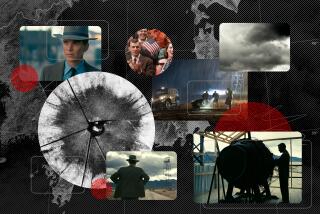A NEW THEORY OF WARFARE: THE ‘THIRD WAVE’ ARRIVES : We Make War the Way We Make Wealth--With Information : Second Wave: Mass Destruction
- Share via
The Industrial Revolution launched the Second Wave of historical change, transforming both war-making and wealth-creation.
Starting with the late 1600s, when the steam engine was introduced to pump water out of British mines, when Newton transformed science, when Descartes rewrote philosophy, when smokestacks began to dot the land, when industrial mass production began to replace peasant-based agriculture in the West, war, too, became progressively industrialized.
Mass production was paralleled by the levee en masse-- the conscription of mass armies paid by, and loyal to, not the local landowner or warlord, but the nation-state. The draft was not new, but the idea of a nation in arms-- Aux armes citoyens!-- was a product of the French Revolution, which roughly marked the crisis of the old agrarian regime and the political rise of the industrializing bourgeois.
Mass production, mass distribution and mass media, so basic to the industrial mass society, were the socio-economic concomitants of mass conscription.
The most dramatic changes in war came from new standardized weaponry that was now produced by mass-production methods (France, for example, was able to turn out 7,000 cannons in 1793, no longer custom producing them by hand.) Soon Eli Whitney in the United States was mass manufacturing muskets.
In fact, war sped up the industrialization process by spreading, for example, the principle of interchangeable parts. This basic industrial innovation was quickly put to use turning out everything from handguns to the pulleys needed on sail-driven warships. That other key industrial principle--standardization--was also soon applied not merely to the weapons themselves but to military training, organization and doctrine as well.
The industrial transformation of war went far beyond technology. Temporary rag-tag armies led by the nobility were replaced by standing armies led by professional officers trained in war academies. The division of labor in industry was reproduced in the rise of new specialized branches of the military. As in business, bureaucracy grew. Armies developed general staffs. Written orders replaced oral commands for many purposes. Memos proliferated in business and on the battlefield.
The “machine age” gave birth to the machine gun, to mechanized warfare and entirely new kinds of firepower which, in turn, led inevitably to new kinds of tactics. Industrialization led to improved roads, harbors, energy supplies and communication. It brought with it the “modern” nation-state with powers of taxation. All of these vastly enlarged the scale of potential military operations.
As early industrialism matured, the economy became part of a larger social system that linked or integrated mass production, mass education, mass communication, mass consumption, mass entertainment--with, increasingly, weapons of mass destruction. Mass destruction was the military expression of industrial mass society. It remains the hallmark of Second Wave warfare.
World War II showed the awesome potential for industrializing death. The Nazis murdered 6,000,000 Jews in true factory style--creating what were, in effect, assembly lines for death. The war itself led to the slaughter of 15,000,000 soldiers and nearly twice that number of civilians.
Thus, even before atomic bombs destroyed Hiroshima and Nagasaki, war had reached unparalleled levels of mass destruction. On March 9, 1945, for example, 334 American B-29 bombers hit Tokyo in a single attack that destroyed 267,171 buildings, killed 84,000 civilians (and wounded 40,000), while flattening 16 square miles of the city.
The general who led the Tokyo raid, Curtis LeMay, who later became chief of the U.S. Strategic Air Command, was the perfect apostle of mass destruction. If war came, he insisted, there was no time for prioritization of targets, nor the technology for precise targeting. To LeMay, writes Fred Kaplan in “The Wizards of Armageddon,” “demolishing everything was how you win a war . . . the whole point of strategic bombing was to be massive.”
Indeed, throughout the entire Cold War following World War II, the ultimate in mass destructive power, nuclear arms, dominated the relationship between the two great superpowers.
As industrial civilization, the world born of the Second Wave of historical change, reached its peak in the post-World War II period, mass destruction came to play the same central role in military doctrine as mass production did in economics.
More to Read
Sign up for Essential California
The most important California stories and recommendations in your inbox every morning.
You may occasionally receive promotional content from the Los Angeles Times.













